Literature Review: Social Skill Training and Spoken Language in Autism
VerifiedAdded on 2022/12/01
|10
|2403
|72
Literature Review
AI Summary
This literature review explores the efficacy of social skill training interventions on children and adolescents with Autism Spectrum Disorder (ASD). The study investigates the challenges faced by children with autism in social interaction and spoken language, as well as different types of social skill interventions. The review focuses on the effectiveness of interventions like Pivotal Response Training (PRT) and Picture Exchange Communication System (PECS) in enhancing social skills and spoken language abilities. It synthesizes findings from various studies, highlighting the positive impact of social skill training on cognitive and social skills. The paper also identifies gaps in the current research, particularly the need for more studies on children aged 8-14 years, and suggests directions for future research to improve intervention strategies. The study concludes that social intervention skills have the potential to improve social skills, spoken language, and cognitive skills in children and young adolescents with autism.
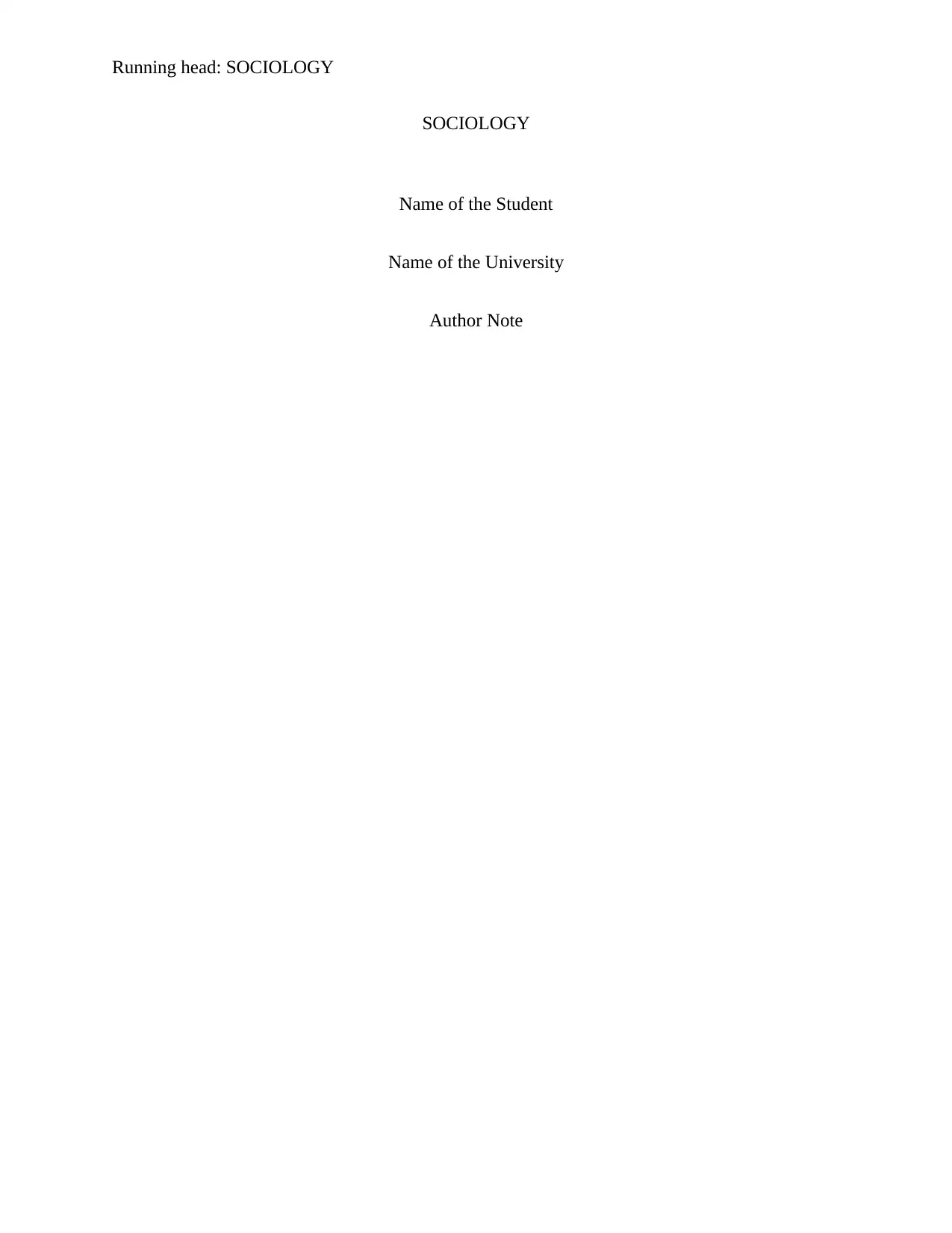
Running head: SOCIOLOGY
SOCIOLOGY
Name of the Student
Name of the University
Author Note
SOCIOLOGY
Name of the Student
Name of the University
Author Note
Paraphrase This Document
Need a fresh take? Get an instant paraphrase of this document with our AI Paraphraser
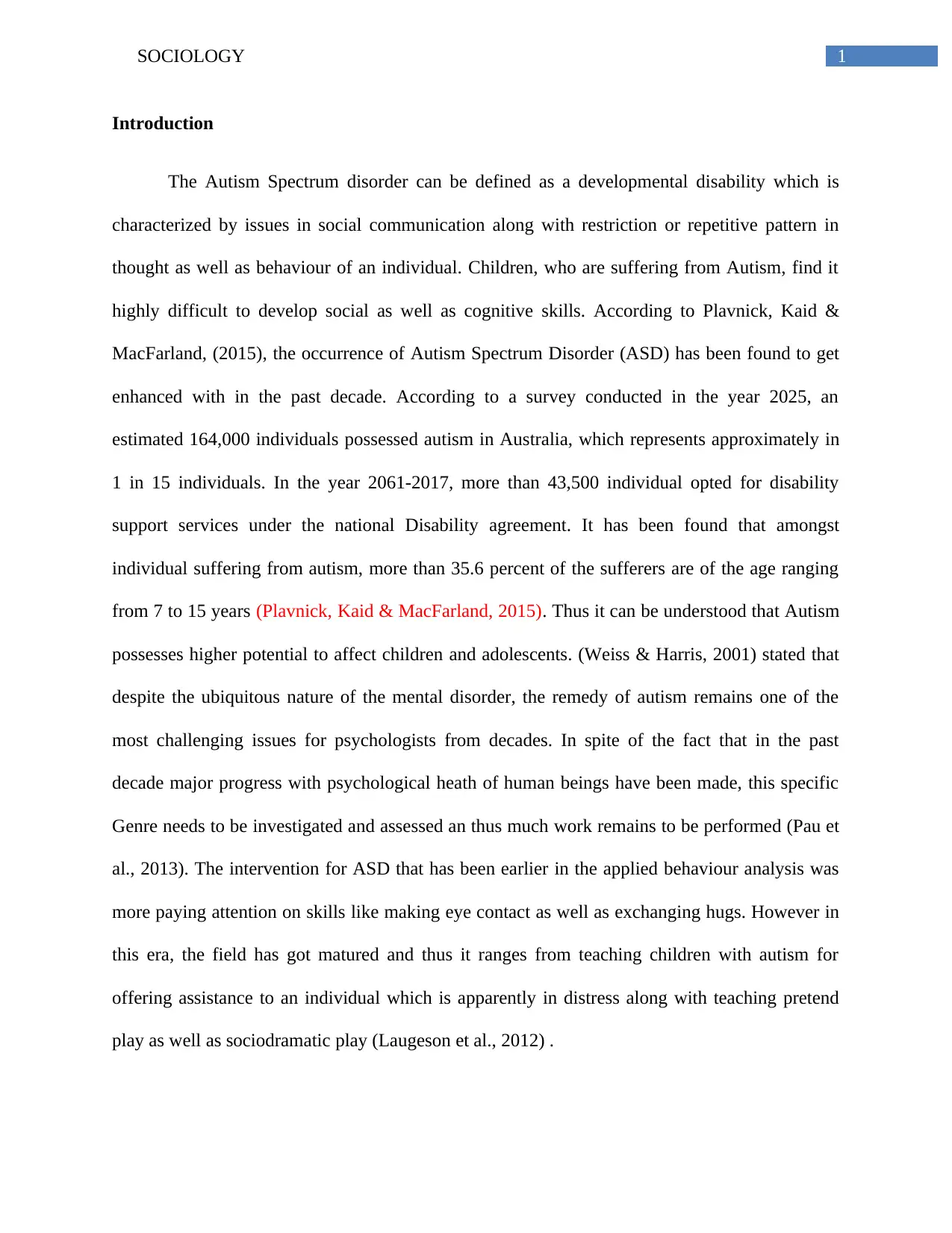
1SOCIOLOGY
Introduction
The Autism Spectrum disorder can be defined as a developmental disability which is
characterized by issues in social communication along with restriction or repetitive pattern in
thought as well as behaviour of an individual. Children, who are suffering from Autism, find it
highly difficult to develop social as well as cognitive skills. According to Plavnick, Kaid &
MacFarland, (2015), the occurrence of Autism Spectrum Disorder (ASD) has been found to get
enhanced with in the past decade. According to a survey conducted in the year 2025, an
estimated 164,000 individuals possessed autism in Australia, which represents approximately in
1 in 15 individuals. In the year 2061-2017, more than 43,500 individual opted for disability
support services under the national Disability agreement. It has been found that amongst
individual suffering from autism, more than 35.6 percent of the sufferers are of the age ranging
from 7 to 15 years (Plavnick, Kaid & MacFarland, 2015). Thus it can be understood that Autism
possesses higher potential to affect children and adolescents. (Weiss & Harris, 2001) stated that
despite the ubiquitous nature of the mental disorder, the remedy of autism remains one of the
most challenging issues for psychologists from decades. In spite of the fact that in the past
decade major progress with psychological heath of human beings have been made, this specific
Genre needs to be investigated and assessed an thus much work remains to be performed (Pau et
al., 2013). The intervention for ASD that has been earlier in the applied behaviour analysis was
more paying attention on skills like making eye contact as well as exchanging hugs. However in
this era, the field has got matured and thus it ranges from teaching children with autism for
offering assistance to an individual which is apparently in distress along with teaching pretend
play as well as sociodramatic play (Laugeson et al., 2012) .
Introduction
The Autism Spectrum disorder can be defined as a developmental disability which is
characterized by issues in social communication along with restriction or repetitive pattern in
thought as well as behaviour of an individual. Children, who are suffering from Autism, find it
highly difficult to develop social as well as cognitive skills. According to Plavnick, Kaid &
MacFarland, (2015), the occurrence of Autism Spectrum Disorder (ASD) has been found to get
enhanced with in the past decade. According to a survey conducted in the year 2025, an
estimated 164,000 individuals possessed autism in Australia, which represents approximately in
1 in 15 individuals. In the year 2061-2017, more than 43,500 individual opted for disability
support services under the national Disability agreement. It has been found that amongst
individual suffering from autism, more than 35.6 percent of the sufferers are of the age ranging
from 7 to 15 years (Plavnick, Kaid & MacFarland, 2015). Thus it can be understood that Autism
possesses higher potential to affect children and adolescents. (Weiss & Harris, 2001) stated that
despite the ubiquitous nature of the mental disorder, the remedy of autism remains one of the
most challenging issues for psychologists from decades. In spite of the fact that in the past
decade major progress with psychological heath of human beings have been made, this specific
Genre needs to be investigated and assessed an thus much work remains to be performed (Pau et
al., 2013). The intervention for ASD that has been earlier in the applied behaviour analysis was
more paying attention on skills like making eye contact as well as exchanging hugs. However in
this era, the field has got matured and thus it ranges from teaching children with autism for
offering assistance to an individual which is apparently in distress along with teaching pretend
play as well as sociodramatic play (Laugeson et al., 2012) .
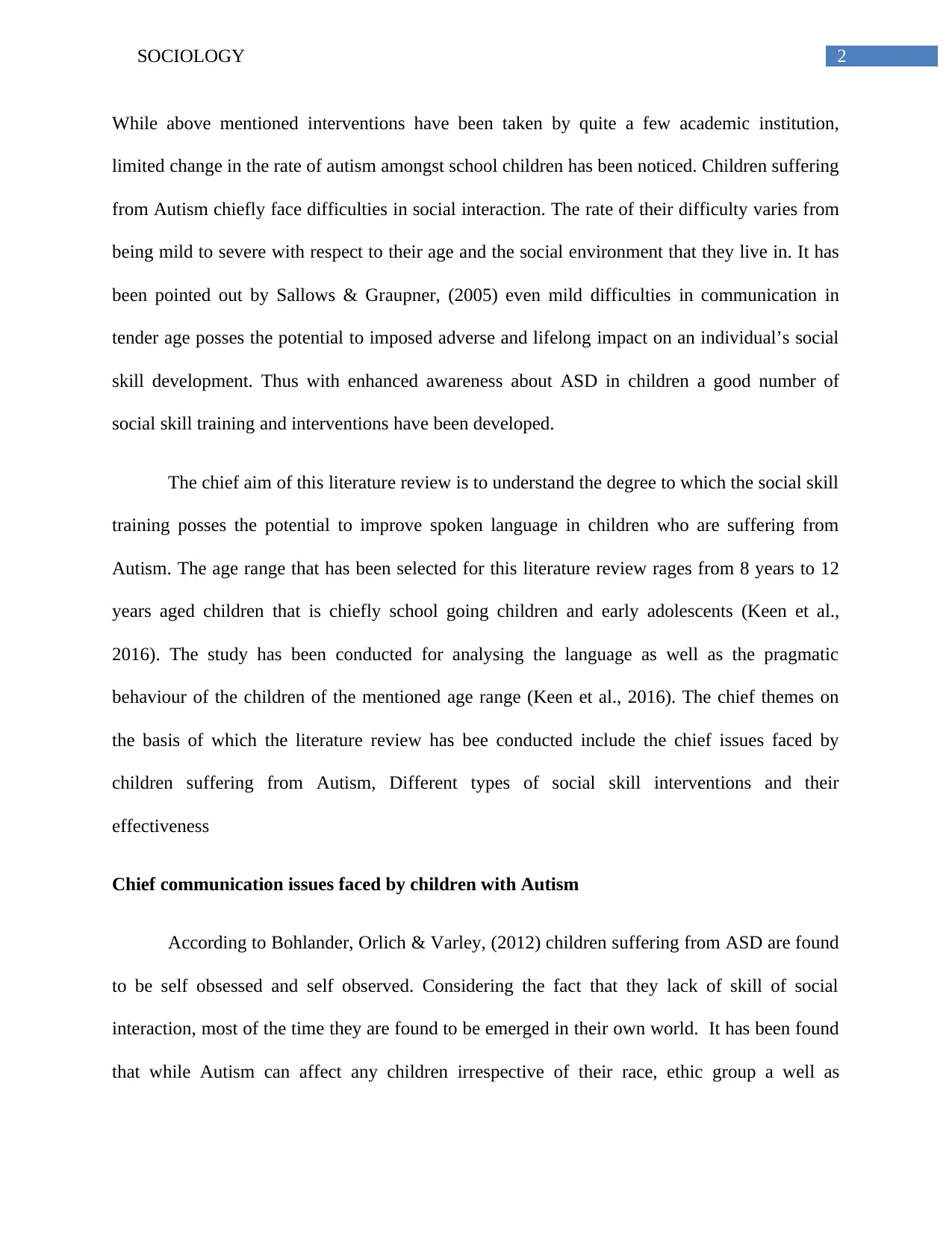
2SOCIOLOGY
While above mentioned interventions have been taken by quite a few academic institution,
limited change in the rate of autism amongst school children has been noticed. Children suffering
from Autism chiefly face difficulties in social interaction. The rate of their difficulty varies from
being mild to severe with respect to their age and the social environment that they live in. It has
been pointed out by Sallows & Graupner, (2005) even mild difficulties in communication in
tender age posses the potential to imposed adverse and lifelong impact on an individual’s social
skill development. Thus with enhanced awareness about ASD in children a good number of
social skill training and interventions have been developed.
The chief aim of this literature review is to understand the degree to which the social skill
training posses the potential to improve spoken language in children who are suffering from
Autism. The age range that has been selected for this literature review rages from 8 years to 12
years aged children that is chiefly school going children and early adolescents (Keen et al.,
2016). The study has been conducted for analysing the language as well as the pragmatic
behaviour of the children of the mentioned age range (Keen et al., 2016). The chief themes on
the basis of which the literature review has bee conducted include the chief issues faced by
children suffering from Autism, Different types of social skill interventions and their
effectiveness
Chief communication issues faced by children with Autism
According to Bohlander, Orlich & Varley, (2012) children suffering from ASD are found
to be self obsessed and self observed. Considering the fact that they lack of skill of social
interaction, most of the time they are found to be emerged in their own world. It has been found
that while Autism can affect any children irrespective of their race, ethic group a well as
While above mentioned interventions have been taken by quite a few academic institution,
limited change in the rate of autism amongst school children has been noticed. Children suffering
from Autism chiefly face difficulties in social interaction. The rate of their difficulty varies from
being mild to severe with respect to their age and the social environment that they live in. It has
been pointed out by Sallows & Graupner, (2005) even mild difficulties in communication in
tender age posses the potential to imposed adverse and lifelong impact on an individual’s social
skill development. Thus with enhanced awareness about ASD in children a good number of
social skill training and interventions have been developed.
The chief aim of this literature review is to understand the degree to which the social skill
training posses the potential to improve spoken language in children who are suffering from
Autism. The age range that has been selected for this literature review rages from 8 years to 12
years aged children that is chiefly school going children and early adolescents (Keen et al.,
2016). The study has been conducted for analysing the language as well as the pragmatic
behaviour of the children of the mentioned age range (Keen et al., 2016). The chief themes on
the basis of which the literature review has bee conducted include the chief issues faced by
children suffering from Autism, Different types of social skill interventions and their
effectiveness
Chief communication issues faced by children with Autism
According to Bohlander, Orlich & Varley, (2012) children suffering from ASD are found
to be self obsessed and self observed. Considering the fact that they lack of skill of social
interaction, most of the time they are found to be emerged in their own world. It has been found
that while Autism can affect any children irrespective of their race, ethic group a well as
⊘ This is a preview!⊘
Do you want full access?
Subscribe today to unlock all pages.

Trusted by 1+ million students worldwide
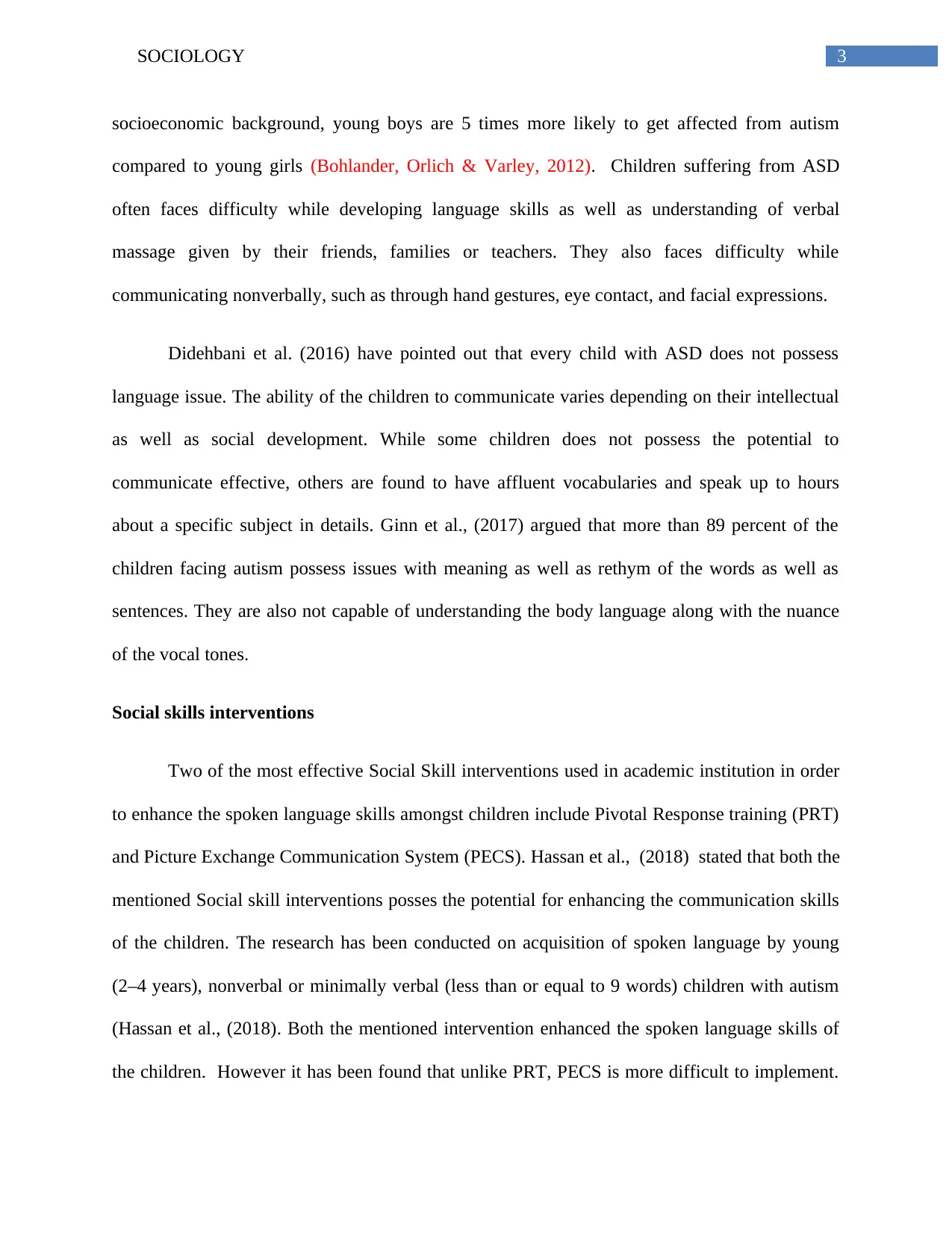
3SOCIOLOGY
socioeconomic background, young boys are 5 times more likely to get affected from autism
compared to young girls (Bohlander, Orlich & Varley, 2012). Children suffering from ASD
often faces difficulty while developing language skills as well as understanding of verbal
massage given by their friends, families or teachers. They also faces difficulty while
communicating nonverbally, such as through hand gestures, eye contact, and facial expressions.
Didehbani et al. (2016) have pointed out that every child with ASD does not possess
language issue. The ability of the children to communicate varies depending on their intellectual
as well as social development. While some children does not possess the potential to
communicate effective, others are found to have affluent vocabularies and speak up to hours
about a specific subject in details. Ginn et al., (2017) argued that more than 89 percent of the
children facing autism possess issues with meaning as well as rethym of the words as well as
sentences. They are also not capable of understanding the body language along with the nuance
of the vocal tones.
Social skills interventions
Two of the most effective Social Skill interventions used in academic institution in order
to enhance the spoken language skills amongst children include Pivotal Response training (PRT)
and Picture Exchange Communication System (PECS). Hassan et al., (2018) stated that both the
mentioned Social skill interventions posses the potential for enhancing the communication skills
of the children. The research has been conducted on acquisition of spoken language by young
(2–4 years), nonverbal or minimally verbal (less than or equal to 9 words) children with autism
(Hassan et al., (2018). Both the mentioned intervention enhanced the spoken language skills of
the children. However it has been found that unlike PRT, PECS is more difficult to implement.
socioeconomic background, young boys are 5 times more likely to get affected from autism
compared to young girls (Bohlander, Orlich & Varley, 2012). Children suffering from ASD
often faces difficulty while developing language skills as well as understanding of verbal
massage given by their friends, families or teachers. They also faces difficulty while
communicating nonverbally, such as through hand gestures, eye contact, and facial expressions.
Didehbani et al. (2016) have pointed out that every child with ASD does not possess
language issue. The ability of the children to communicate varies depending on their intellectual
as well as social development. While some children does not possess the potential to
communicate effective, others are found to have affluent vocabularies and speak up to hours
about a specific subject in details. Ginn et al., (2017) argued that more than 89 percent of the
children facing autism possess issues with meaning as well as rethym of the words as well as
sentences. They are also not capable of understanding the body language along with the nuance
of the vocal tones.
Social skills interventions
Two of the most effective Social Skill interventions used in academic institution in order
to enhance the spoken language skills amongst children include Pivotal Response training (PRT)
and Picture Exchange Communication System (PECS). Hassan et al., (2018) stated that both the
mentioned Social skill interventions posses the potential for enhancing the communication skills
of the children. The research has been conducted on acquisition of spoken language by young
(2–4 years), nonverbal or minimally verbal (less than or equal to 9 words) children with autism
(Hassan et al., (2018). Both the mentioned intervention enhanced the spoken language skills of
the children. However it has been found that unlike PRT, PECS is more difficult to implement.
Paraphrase This Document
Need a fresh take? Get an instant paraphrase of this document with our AI Paraphraser
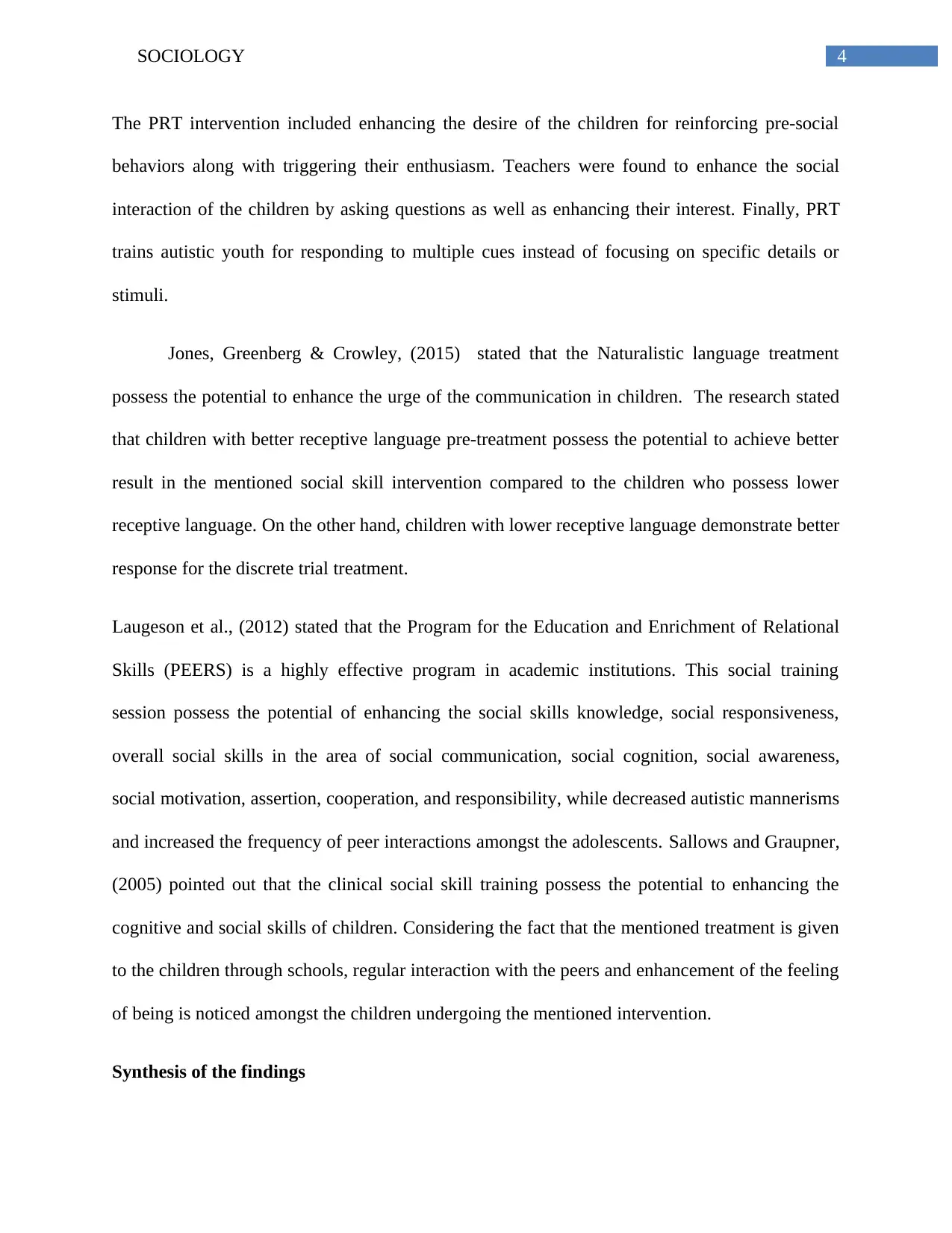
4SOCIOLOGY
The PRT intervention included enhancing the desire of the children for reinforcing pre-social
behaviors along with triggering their enthusiasm. Teachers were found to enhance the social
interaction of the children by asking questions as well as enhancing their interest. Finally, PRT
trains autistic youth for responding to multiple cues instead of focusing on specific details or
stimuli.
Jones, Greenberg & Crowley, (2015) stated that the Naturalistic language treatment
possess the potential to enhance the urge of the communication in children. The research stated
that children with better receptive language pre-treatment possess the potential to achieve better
result in the mentioned social skill intervention compared to the children who possess lower
receptive language. On the other hand, children with lower receptive language demonstrate better
response for the discrete trial treatment.
Laugeson et al., (2012) stated that the Program for the Education and Enrichment of Relational
Skills (PEERS) is a highly effective program in academic institutions. This social training
session possess the potential of enhancing the social skills knowledge, social responsiveness,
overall social skills in the area of social communication, social cognition, social awareness,
social motivation, assertion, cooperation, and responsibility, while decreased autistic mannerisms
and increased the frequency of peer interactions amongst the adolescents. Sallows and Graupner,
(2005) pointed out that the clinical social skill training possess the potential to enhancing the
cognitive and social skills of children. Considering the fact that the mentioned treatment is given
to the children through schools, regular interaction with the peers and enhancement of the feeling
of being is noticed amongst the children undergoing the mentioned intervention.
Synthesis of the findings
The PRT intervention included enhancing the desire of the children for reinforcing pre-social
behaviors along with triggering their enthusiasm. Teachers were found to enhance the social
interaction of the children by asking questions as well as enhancing their interest. Finally, PRT
trains autistic youth for responding to multiple cues instead of focusing on specific details or
stimuli.
Jones, Greenberg & Crowley, (2015) stated that the Naturalistic language treatment
possess the potential to enhance the urge of the communication in children. The research stated
that children with better receptive language pre-treatment possess the potential to achieve better
result in the mentioned social skill intervention compared to the children who possess lower
receptive language. On the other hand, children with lower receptive language demonstrate better
response for the discrete trial treatment.
Laugeson et al., (2012) stated that the Program for the Education and Enrichment of Relational
Skills (PEERS) is a highly effective program in academic institutions. This social training
session possess the potential of enhancing the social skills knowledge, social responsiveness,
overall social skills in the area of social communication, social cognition, social awareness,
social motivation, assertion, cooperation, and responsibility, while decreased autistic mannerisms
and increased the frequency of peer interactions amongst the adolescents. Sallows and Graupner,
(2005) pointed out that the clinical social skill training possess the potential to enhancing the
cognitive and social skills of children. Considering the fact that the mentioned treatment is given
to the children through schools, regular interaction with the peers and enhancement of the feeling
of being is noticed amongst the children undergoing the mentioned intervention.
Synthesis of the findings
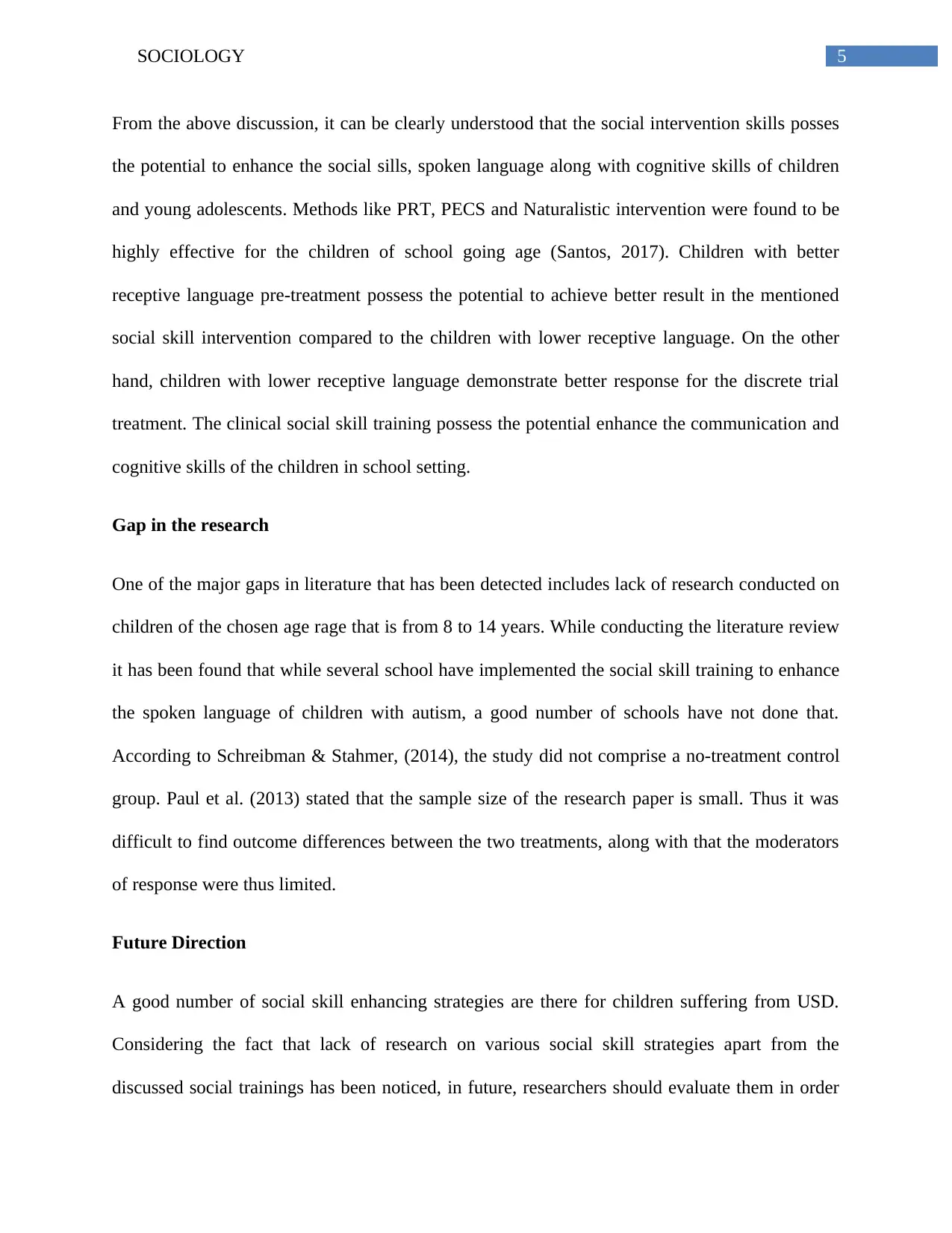
5SOCIOLOGY
From the above discussion, it can be clearly understood that the social intervention skills posses
the potential to enhance the social sills, spoken language along with cognitive skills of children
and young adolescents. Methods like PRT, PECS and Naturalistic intervention were found to be
highly effective for the children of school going age (Santos, 2017). Children with better
receptive language pre-treatment possess the potential to achieve better result in the mentioned
social skill intervention compared to the children with lower receptive language. On the other
hand, children with lower receptive language demonstrate better response for the discrete trial
treatment. The clinical social skill training possess the potential enhance the communication and
cognitive skills of the children in school setting.
Gap in the research
One of the major gaps in literature that has been detected includes lack of research conducted on
children of the chosen age rage that is from 8 to 14 years. While conducting the literature review
it has been found that while several school have implemented the social skill training to enhance
the spoken language of children with autism, a good number of schools have not done that.
According to Schreibman & Stahmer, (2014), the study did not comprise a no-treatment control
group. Paul et al. (2013) stated that the sample size of the research paper is small. Thus it was
difficult to find outcome differences between the two treatments, along with that the moderators
of response were thus limited.
Future Direction
A good number of social skill enhancing strategies are there for children suffering from USD.
Considering the fact that lack of research on various social skill strategies apart from the
discussed social trainings has been noticed, in future, researchers should evaluate them in order
From the above discussion, it can be clearly understood that the social intervention skills posses
the potential to enhance the social sills, spoken language along with cognitive skills of children
and young adolescents. Methods like PRT, PECS and Naturalistic intervention were found to be
highly effective for the children of school going age (Santos, 2017). Children with better
receptive language pre-treatment possess the potential to achieve better result in the mentioned
social skill intervention compared to the children with lower receptive language. On the other
hand, children with lower receptive language demonstrate better response for the discrete trial
treatment. The clinical social skill training possess the potential enhance the communication and
cognitive skills of the children in school setting.
Gap in the research
One of the major gaps in literature that has been detected includes lack of research conducted on
children of the chosen age rage that is from 8 to 14 years. While conducting the literature review
it has been found that while several school have implemented the social skill training to enhance
the spoken language of children with autism, a good number of schools have not done that.
According to Schreibman & Stahmer, (2014), the study did not comprise a no-treatment control
group. Paul et al. (2013) stated that the sample size of the research paper is small. Thus it was
difficult to find outcome differences between the two treatments, along with that the moderators
of response were thus limited.
Future Direction
A good number of social skill enhancing strategies are there for children suffering from USD.
Considering the fact that lack of research on various social skill strategies apart from the
discussed social trainings has been noticed, in future, researchers should evaluate them in order
⊘ This is a preview!⊘
Do you want full access?
Subscribe today to unlock all pages.

Trusted by 1+ million students worldwide
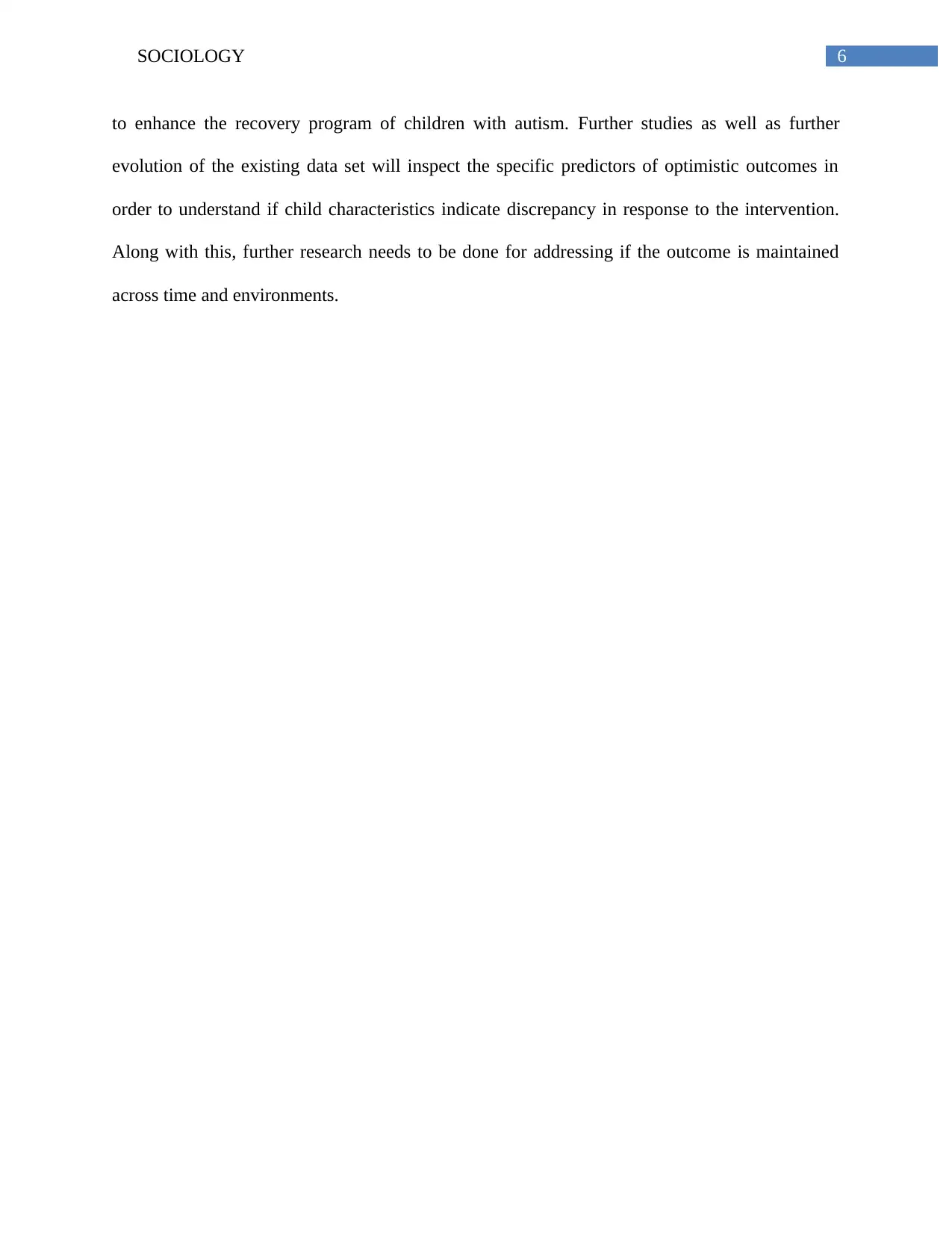
6SOCIOLOGY
to enhance the recovery program of children with autism. Further studies as well as further
evolution of the existing data set will inspect the specific predictors of optimistic outcomes in
order to understand if child characteristics indicate discrepancy in response to the intervention.
Along with this, further research needs to be done for addressing if the outcome is maintained
across time and environments.
to enhance the recovery program of children with autism. Further studies as well as further
evolution of the existing data set will inspect the specific predictors of optimistic outcomes in
order to understand if child characteristics indicate discrepancy in response to the intervention.
Along with this, further research needs to be done for addressing if the outcome is maintained
across time and environments.
Paraphrase This Document
Need a fresh take? Get an instant paraphrase of this document with our AI Paraphraser
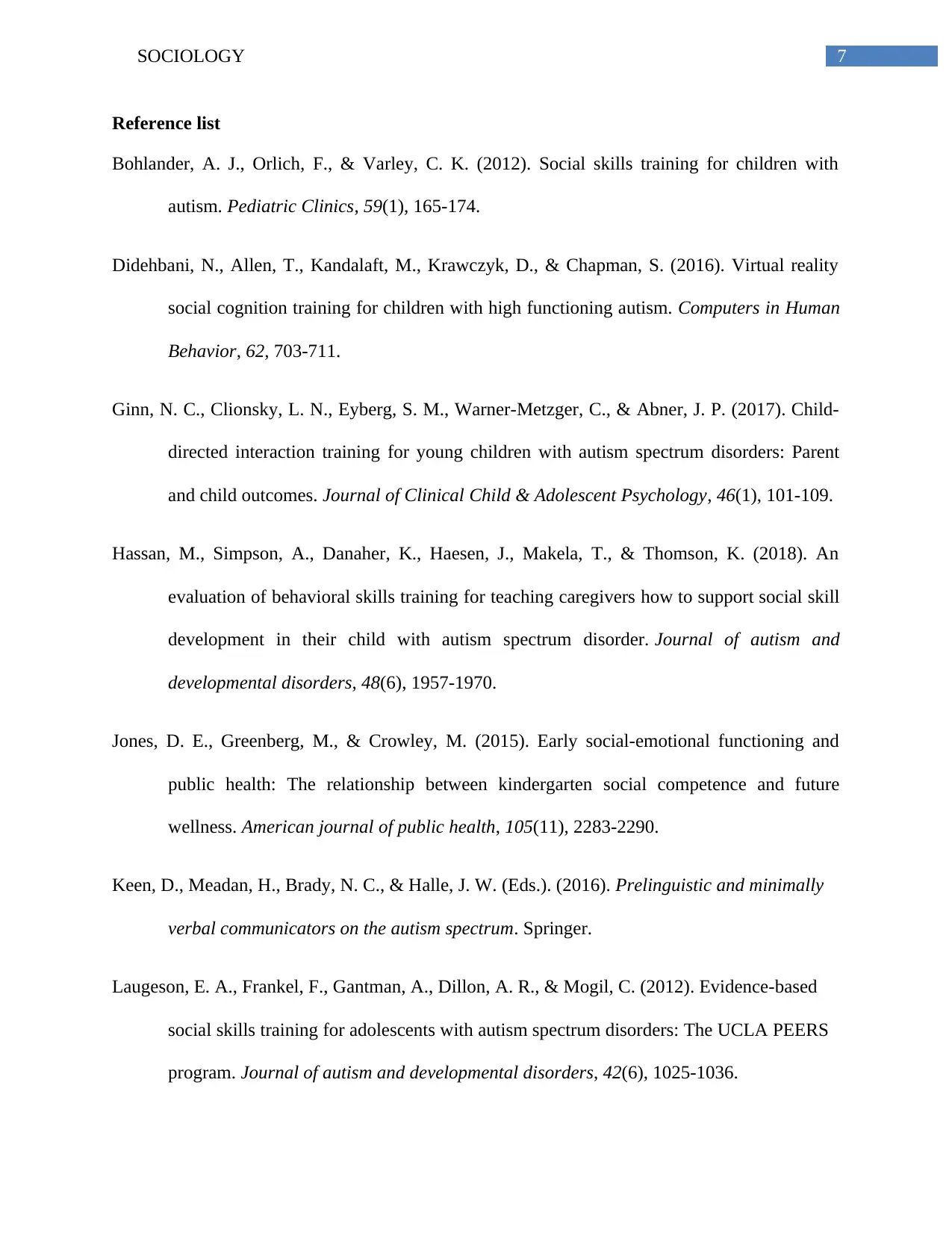
7SOCIOLOGY
Reference list
Bohlander, A. J., Orlich, F., & Varley, C. K. (2012). Social skills training for children with
autism. Pediatric Clinics, 59(1), 165-174.
Didehbani, N., Allen, T., Kandalaft, M., Krawczyk, D., & Chapman, S. (2016). Virtual reality
social cognition training for children with high functioning autism. Computers in Human
Behavior, 62, 703-711.
Ginn, N. C., Clionsky, L. N., Eyberg, S. M., Warner-Metzger, C., & Abner, J. P. (2017). Child-
directed interaction training for young children with autism spectrum disorders: Parent
and child outcomes. Journal of Clinical Child & Adolescent Psychology, 46(1), 101-109.
Hassan, M., Simpson, A., Danaher, K., Haesen, J., Makela, T., & Thomson, K. (2018). An
evaluation of behavioral skills training for teaching caregivers how to support social skill
development in their child with autism spectrum disorder. Journal of autism and
developmental disorders, 48(6), 1957-1970.
Jones, D. E., Greenberg, M., & Crowley, M. (2015). Early social-emotional functioning and
public health: The relationship between kindergarten social competence and future
wellness. American journal of public health, 105(11), 2283-2290.
Keen, D., Meadan, H., Brady, N. C., & Halle, J. W. (Eds.). (2016). Prelinguistic and minimally
verbal communicators on the autism spectrum. Springer.
Laugeson, E. A., Frankel, F., Gantman, A., Dillon, A. R., & Mogil, C. (2012). Evidence-based
social skills training for adolescents with autism spectrum disorders: The UCLA PEERS
program. Journal of autism and developmental disorders, 42(6), 1025-1036.
Reference list
Bohlander, A. J., Orlich, F., & Varley, C. K. (2012). Social skills training for children with
autism. Pediatric Clinics, 59(1), 165-174.
Didehbani, N., Allen, T., Kandalaft, M., Krawczyk, D., & Chapman, S. (2016). Virtual reality
social cognition training for children with high functioning autism. Computers in Human
Behavior, 62, 703-711.
Ginn, N. C., Clionsky, L. N., Eyberg, S. M., Warner-Metzger, C., & Abner, J. P. (2017). Child-
directed interaction training for young children with autism spectrum disorders: Parent
and child outcomes. Journal of Clinical Child & Adolescent Psychology, 46(1), 101-109.
Hassan, M., Simpson, A., Danaher, K., Haesen, J., Makela, T., & Thomson, K. (2018). An
evaluation of behavioral skills training for teaching caregivers how to support social skill
development in their child with autism spectrum disorder. Journal of autism and
developmental disorders, 48(6), 1957-1970.
Jones, D. E., Greenberg, M., & Crowley, M. (2015). Early social-emotional functioning and
public health: The relationship between kindergarten social competence and future
wellness. American journal of public health, 105(11), 2283-2290.
Keen, D., Meadan, H., Brady, N. C., & Halle, J. W. (Eds.). (2016). Prelinguistic and minimally
verbal communicators on the autism spectrum. Springer.
Laugeson, E. A., Frankel, F., Gantman, A., Dillon, A. R., & Mogil, C. (2012). Evidence-based
social skills training for adolescents with autism spectrum disorders: The UCLA PEERS
program. Journal of autism and developmental disorders, 42(6), 1025-1036.
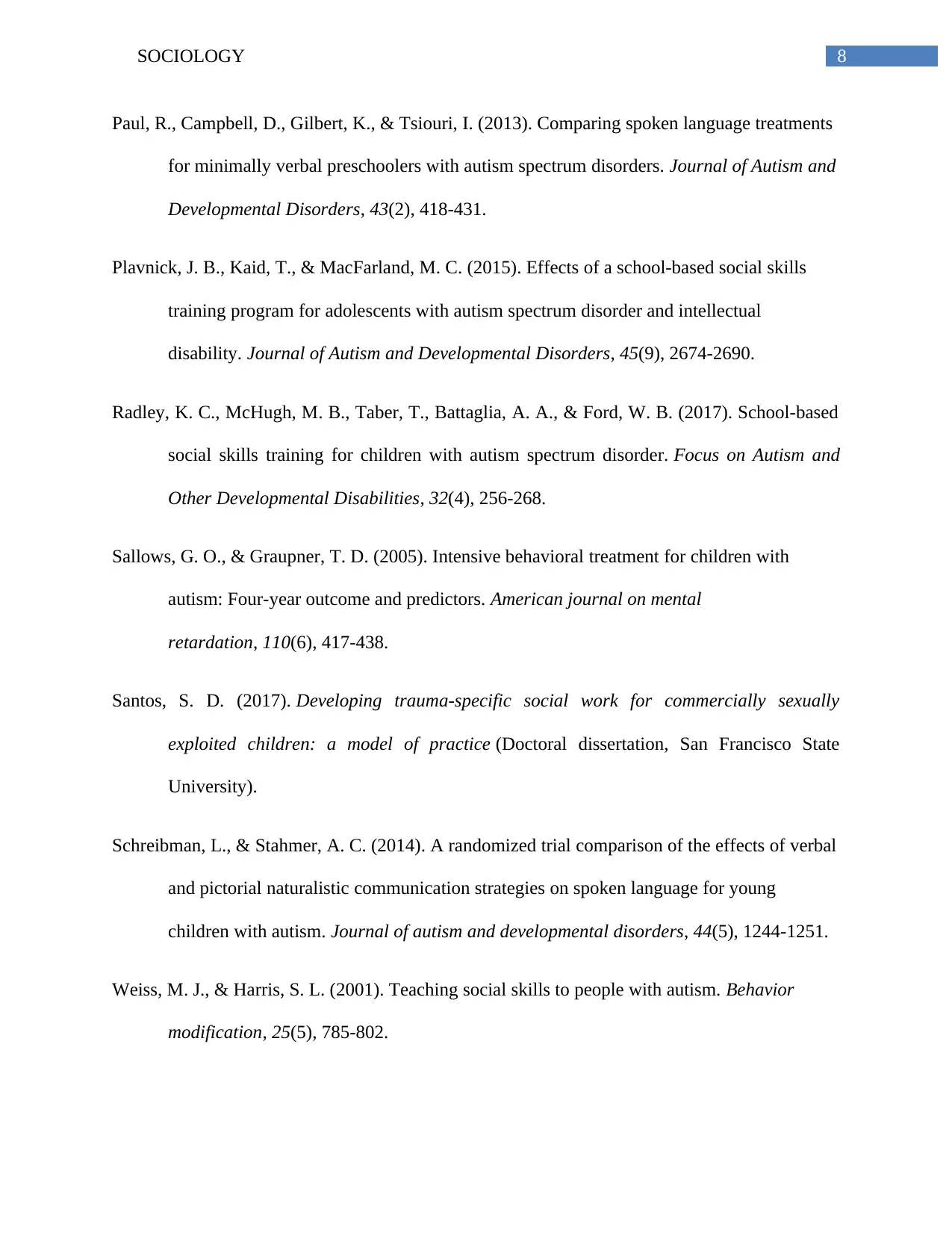
8SOCIOLOGY
Paul, R., Campbell, D., Gilbert, K., & Tsiouri, I. (2013). Comparing spoken language treatments
for minimally verbal preschoolers with autism spectrum disorders. Journal of Autism and
Developmental Disorders, 43(2), 418-431.
Plavnick, J. B., Kaid, T., & MacFarland, M. C. (2015). Effects of a school-based social skills
training program for adolescents with autism spectrum disorder and intellectual
disability. Journal of Autism and Developmental Disorders, 45(9), 2674-2690.
Radley, K. C., McHugh, M. B., Taber, T., Battaglia, A. A., & Ford, W. B. (2017). School-based
social skills training for children with autism spectrum disorder. Focus on Autism and
Other Developmental Disabilities, 32(4), 256-268.
Sallows, G. O., & Graupner, T. D. (2005). Intensive behavioral treatment for children with
autism: Four-year outcome and predictors. American journal on mental
retardation, 110(6), 417-438.
Santos, S. D. (2017). Developing trauma-specific social work for commercially sexually
exploited children: a model of practice (Doctoral dissertation, San Francisco State
University).
Schreibman, L., & Stahmer, A. C. (2014). A randomized trial comparison of the effects of verbal
and pictorial naturalistic communication strategies on spoken language for young
children with autism. Journal of autism and developmental disorders, 44(5), 1244-1251.
Weiss, M. J., & Harris, S. L. (2001). Teaching social skills to people with autism. Behavior
modification, 25(5), 785-802.
Paul, R., Campbell, D., Gilbert, K., & Tsiouri, I. (2013). Comparing spoken language treatments
for minimally verbal preschoolers with autism spectrum disorders. Journal of Autism and
Developmental Disorders, 43(2), 418-431.
Plavnick, J. B., Kaid, T., & MacFarland, M. C. (2015). Effects of a school-based social skills
training program for adolescents with autism spectrum disorder and intellectual
disability. Journal of Autism and Developmental Disorders, 45(9), 2674-2690.
Radley, K. C., McHugh, M. B., Taber, T., Battaglia, A. A., & Ford, W. B. (2017). School-based
social skills training for children with autism spectrum disorder. Focus on Autism and
Other Developmental Disabilities, 32(4), 256-268.
Sallows, G. O., & Graupner, T. D. (2005). Intensive behavioral treatment for children with
autism: Four-year outcome and predictors. American journal on mental
retardation, 110(6), 417-438.
Santos, S. D. (2017). Developing trauma-specific social work for commercially sexually
exploited children: a model of practice (Doctoral dissertation, San Francisco State
University).
Schreibman, L., & Stahmer, A. C. (2014). A randomized trial comparison of the effects of verbal
and pictorial naturalistic communication strategies on spoken language for young
children with autism. Journal of autism and developmental disorders, 44(5), 1244-1251.
Weiss, M. J., & Harris, S. L. (2001). Teaching social skills to people with autism. Behavior
modification, 25(5), 785-802.
⊘ This is a preview!⊘
Do you want full access?
Subscribe today to unlock all pages.

Trusted by 1+ million students worldwide

9SOCIOLOGY
1 out of 10
Related Documents
Your All-in-One AI-Powered Toolkit for Academic Success.
+13062052269
info@desklib.com
Available 24*7 on WhatsApp / Email
![[object Object]](/_next/static/media/star-bottom.7253800d.svg)
Unlock your academic potential
Copyright © 2020–2025 A2Z Services. All Rights Reserved. Developed and managed by ZUCOL.





